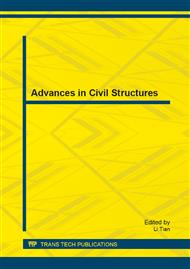p.1673
p.1677
p.1683
p.1687
p.1694
p.1700
p.1706
p.1710
p.1714
The Research of Predicting the Carbonation Depth of Concrete with Time-Series Analysis
Abstract:
This paper analysis and reviews the calculation and the predicting model of concrete carbonation depth, also discusses the influence factors of concrete carbonization and the applicability of the predicting model. In order to reduce or avoid the effect of complex factors such as material composition, humidity and temperature on the calculation of the carbonation depth and the prediction results, the predicting model of concrete carbonation depth based on the time-series changes is investigated. In this model, Box-Jenkins time series analysis is utilized to establish the regression model-AR model, which reflect the concrete carbonation depth changes over time. The research and analysis shows that the model has characteristics of simple and high precision, and with the measured data increased and updated, the prediction result is getting better and better. Using this method to evaluate the life of concrete structures which under the affection of carbonation, only need to test the carbonation depth of concrete, and the other parameters is not need consider.
Info:
Periodical:
Pages:
1694-1699
Citation:
Online since:
August 2013
Authors:
Price:
Сopyright:
© 2013 Trans Tech Publications Ltd. All Rights Reserved
Share:
Citation:


